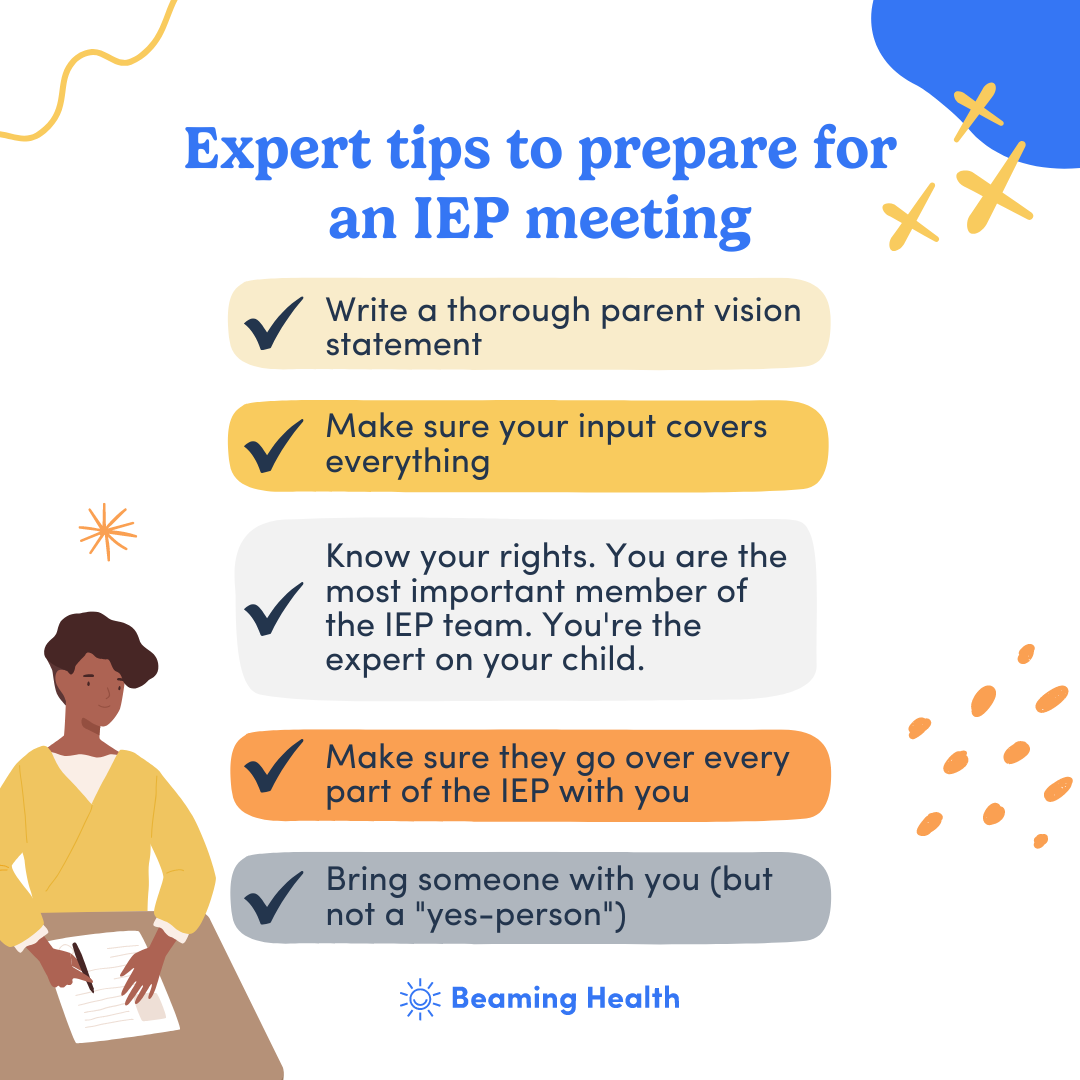Individualized Education Programs (IEPs): What should be in an IEP?
Updated: August 11, 2023 · 5 Minute Read

Reviewed by:
Lisa M. Carey, Education Advocate at Undivided
Highlights
- An IEP includes important details about your child’s education plan.
- An IEP most likely has sections about your child’s goals, progress tracker, services, and transition plan (just to name a few).
- An IEP shouldn’t include goals for free time, exposure therapy, or plans for a restrictive environment (just to name a few).
Individualized Education Program (IEP): What should be in an IEP?
Your child’s actual IEP may vary depending on the district and the state you live in and your child’s individual circumstances. But generally, all IEPs have some stuff in common:
- The student’s information and the names of everyone on the IEP team.
- The student’s “present level of performance.” This is your child’s current strengths, challenges, abilities, etc. This is academic performance but can also include other things like social skills and behavior.
- An annual goals section. These are the student’s academic and functional goals for the year, which are also broken down into smaller goals. These should be based on the evaluation from earlier, with reasonable and individualized goals to what your child is good at and what they need help with. While functional and social skills goals can be a valuable part of the student’s IEP, the main point of goals should be supporting the child in learning the curriculum.
- A reporting section. This should describe how the student’s progress will be tracked, measured, and when.
- A services section. This should describe all the special education services the student will get and for how long. This can include services inside and outside of the school year, and transition planning as the student gets ready to become an adult. Learn the difference between supports and services.
- Aids, services, and accommodations. This section will outline any additional supports the student needs to help them be successful. It can include things like changing their assigned seat, getting less homework, having tests administered orally instead of in writing, or assistive technology (like an AAC device).
- Participation in general education and other activities. This part of the IEP outlines how (and in what ways) the student will be involved in general education classes and activities like standardized testing.
- Consent and signature. This final portion is where you’d sign the IEP to make it legally binding and effective.
- Transition planning. As the child gets older, transition planning should also be included in the IEP. The required age for transition planning varies from state to state, but it’s usually 14–16 years old. You want to start at 14 or sooner, if possible.
To learn more about what’s in an IEP, check out the Anatomy of an IEP. You may also want to learn some common IEP terms.
What should not be in an IEP?
Your child’s IEP could include all kinds of things (potty training and job skills, just to name a couple), but there are also some things it shouldn’t include. An autistic or neurodivergent child’s IEP should NOT include:
- Goals during free time/recess. A neurodivergent child should be able to enjoy free time and play just like anyone else. A student’s free time or recess time shouldn’t be taken away as punishment for not meeting a goal or expectation, either.
- Goals to stop or reduce stimming. As long as the stimming is not harming the child or anyone else. Autistic and neurodivergent kids stim to focus, self-soothe, and just out of happiness. Stimming shouldn’t be reduced or stopped unless it’s hurting someone.
- Goals to force eye contact or stop/reduce echolalia. Eye contact is uncomfortable for many autistic people and shouldn’t be forced. Eye contact should not be a goal in any child’s IEP. Echolalia is a primary way some autistic and speech-delayed kids communicate. Echolalia shouldn’t be discouraged or stopped, either.
- Goals using deprivation as a motivator for behavior. An example of a motivator is when a student will say “snack” or point to the picture for a snack before being allowed to eat their snack. Using deprivation is abusive and should not be part of any child’s IEP.
- Goals that use demands/trying to build tolerance to triggers through exposure. An example is when a student is asked to sit calmly during music time beginning with increments of 30 seconds and working up to 3 minutes. If something (like music) bothers a student, the school should help them with accommodations (like noise-canceling headphones), not exposing them to the harmful thing. Tolerance through exposure shouldn’t be included in an IEP.
- Goals for neurotypical social skills or behavior. An example is when a student is asked to listen to a peer’s topic of choice for 5 minutes without interrupting and ask appropriate questions in a friendly tone. Instead of trying to teach autistic kids how to socialize in a neurotypical way, social skills goals should look more like teaching the student to self-advocate, roleplaying common conversational pitfalls, and overall increasing the student’s comfort in social interactions.
- Goals that discourage the student from self-advocating or encourage the student to deny their autonomy. For example, when a student is asked by the teacher to perform a task, a student learns to say “yes, sir” or “yes, ma’am” and immediately do the task. Another example is that a student needs to learn to laugh along when peers tease them. Goals like these encourage autistic students to deny their own safety and feelings in order to please others, which can be dangerous and set them up for abusive situations later on.
- Restrictive environment. IDEA laws require disabled students to be in the least restrictive environment (LRE) possible. If a student’s IEP team (or teachers) plan to keep them in a self-contained classroom for more than 80% of the school day, that’s a red flag. They’d better have a really good (and valid) reason for doing so. If school staff are restricting a child’s environment and it’s not in the IEP, that’s a big problem, too. Autistic and neurodivergent kids should always be integrated as much as possible into the same school environment as their peers (with accommodations as needed).
For more examples of what should NOT be included in an autistic or neurodivergent child’s IEP, please check out IEP Makeovers Part 1 and IEP Makeovers Part 2. Here’s some help for creating strength-based and effective IEP goals.

How often can the IEP change?
A child’s IEP can be modified at any time. Every year you’ll work with the rest of the IEP team to create an IEP for that school year and the upcoming year. But you can request changes to your child’s IEP at any time if you feel it’s not meeting their needs. The school may not always grant your request to change the IEP, which is why learning how to advocate for your child is very important. The school is not allowed to make changes to your child’s IEP or create the IEP without you. Learn more about IEP meetings here.
Get our best articles delivered to your inbox each month.
We respect your privacy.













